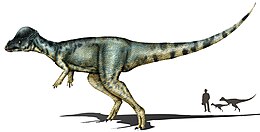Alaskacephale
| Alaskacephale Temporal range: Early Campanian to Middle Maastrichtian,
| |
|---|---|

| |
| Scientific classification | |
| Kingdom: | Animalia |
| Phylum: | Chordata |
| Clade: | Dinosauria |
| Order: | †Ornithischia |
| Suborder: | †Pachycephalosauria |
| Family: | †Pachycephalosauridae |
| Genus: | †Alaskacephale Sullivan, 2006 |
| Species: | †A. gangloffi
|
| Binomial name | |
| †Alaskacephale gangloffi Sullivan, 2006
| |
Alaskacephale was a genus of pachycephalosaurid dinosaur that lived in the late Campanian to Maastrichtian stages of the Late Cretaceous (around 80 to 69 million years ago).
Alaskacephale was named by Robert Sullivan in 2006.[1] The genus name refers to Alaska, where the holotype was discovered, combined with the Greek kephale, meaning head. The species name, gangloffi, honors paleontologist Roland Gangloff. The only known specimen of A. gangloffi is the holotype UAM AK-493-V-001, found in 1999, a nearly complete left squamosal with a characteristic array of polygonal nodes. The dimensions of this bone suggest that A. gangloffi was about half the size of Pachycephalosaurus wyomingensis or three quarters the size of Prenocephale, and about the same size as "Prenocephale" edmontonensis and Foraminacephale.[2]
The specimen was previously described by Gangloff et al. (2005) as an unnamed pachycephalosaurid, possibly a Pachycephalosaurus. Gangloff et al. described the squamosal as having an interdigitated suture with the quadrate, a feature previously described only in Pachycephalosaurus. Sullivan (2006) opined that this "suture" is instead a breakage point in both Alaskacephale and Pachycephalosaurus, so it could not be used to unite the two taxa.
See also[]
References[]
- ^ Sullivan, RM (2006). "A taxonomic review of the Pachycephalosauridae (Dinosauria: Ornithischia)" (PDF). New Mexico Museum of Natural History and Science Bulletin (35): 347–365.
- ^ Gangloff, R.A.; A.R. Fiorillo; D.W. Norton (2005). "The first pachycephalosaurine (Dinosauria) from the Paleo-Arctic of Alaska and its paleogeographic implications". Journal of Paleontology. 79 (5): 997–1001. doi:10.1666/0022-3360(2005)079[0997:tfpdft]2.0.co;2.
- Late Cretaceous dinosaurs of North America
- Fossil taxa described in 2006
- Pachycephalosaurs
- Paleontology in Alaska
- Campanian genus extinctions
- Campanian genus first appearances
- Ornithischian genera




